MIAMI — Dr. Alfonso Sabater pulled up two photos of Antonio Vento Carvajal’s eyes. One showed cloudy scars covering both eyeballs. The other, taken after months of gene therapy given through eyedrops, revealed no scarring on either eye.
Antonio, who’s been legally blind for much of his 14 years, can see again.
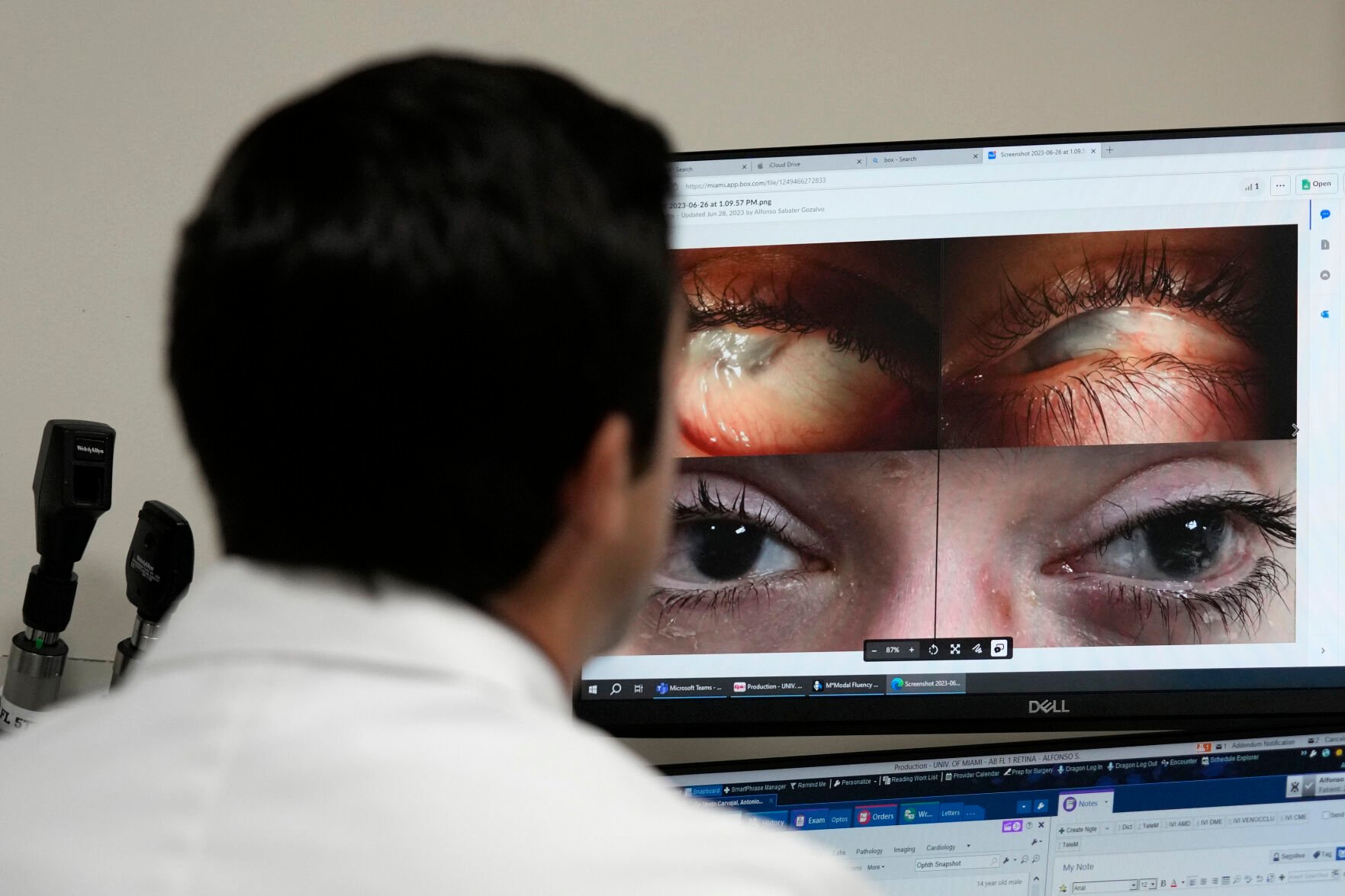
Wilfredo Lee, Associated Press
Dr. Alfonso Sabater, left, pulls up photos of Antonio Vento Carvajal's eyes photographed before and after surgery and gene therapy, Thursday, July 6, 2023, at University of Miami Health System's Bascom Palmer Eye Institute in Miami.
The teen was born with dystrophic epidermolysis bullosa, a rare genetic condition that causes blisters all over his body and in his eyes. But his skin improved when he joined a clinical trial to test the world’s first topical gene therapy. That gave Sabater an idea: What if it could be adapted for Antonio’s eyes?
This insight not only helped Antonio, it also opened the door to similar therapies that could potentially treat millions of people with other eye diseases, including common ones.
Antonio’s mom, Yunielkys “Yuni” Carvajal, teared up thinking about what Sabater did for her son.
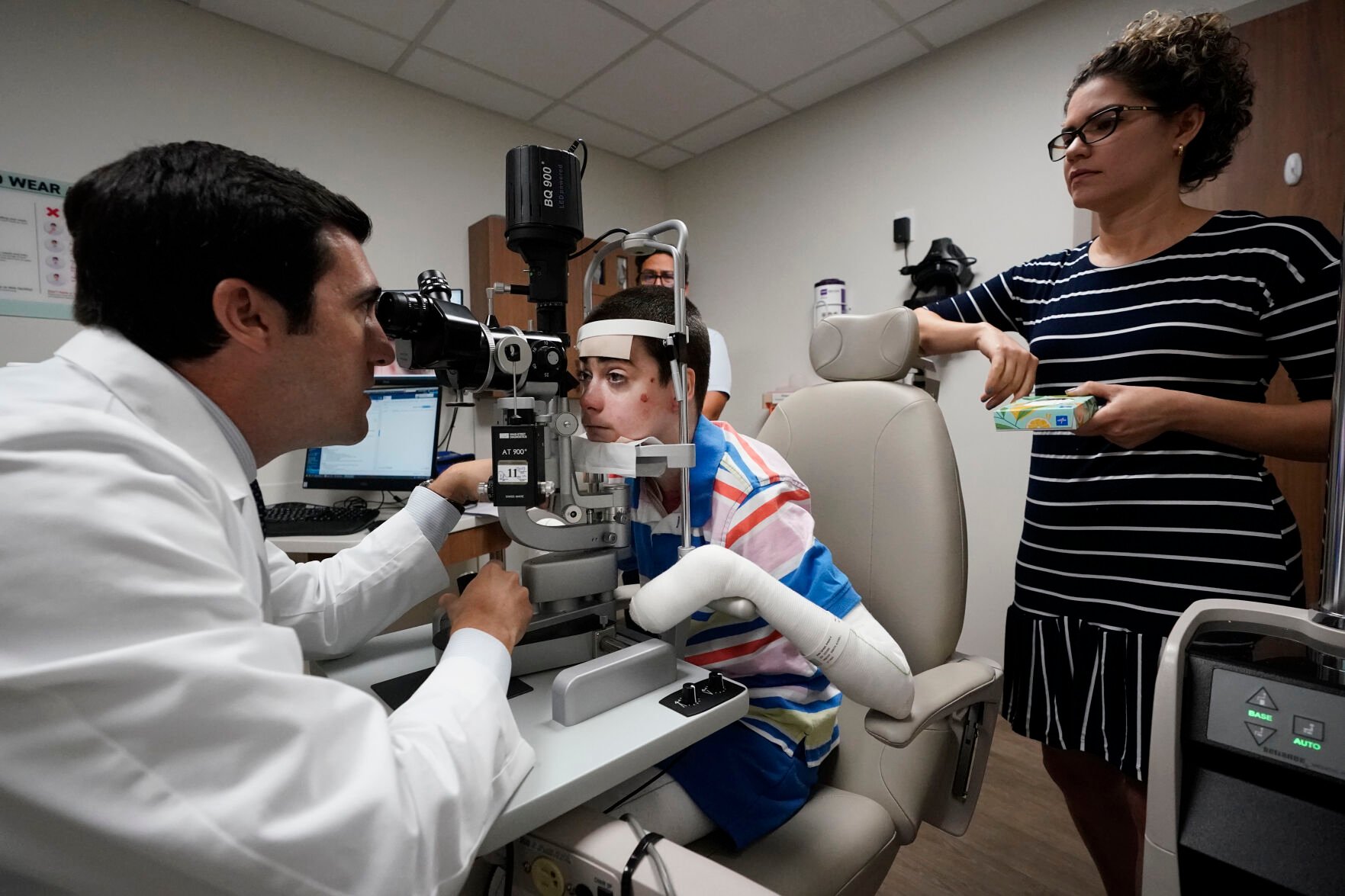
Wilfredo Lee, Associated Press
Dr. Alfonso Sabater, left, examines Antonio Vento Carvajal's eyes accompanied by his mother, Yunielkys Carvajal, right, Thursday, July 6, 2023, at University of Miami Health System's Bascom Palmer Eye Institute in Miami.
“He’s been there through everything,” she said in Spanish during a visit to the University of Miami Health System’s Bascom Palmer Eye Institute. “He’s not only a good doctor but such a good human being and provided us with hope. He never gave up.”
The family came to the U.S. from Cuba in 2012 on a special visa allowing Antonio to get treatment for his condition, which affects around 3,000 people worldwide. He had surgeries to remove scar tissue from his eyes, but it grew back. Antonio’s vision kept getting worse, eventually deteriorating so much that he didn’t feel safe walking around.
Sabater had no answers then, and tried to reassure the boy: “I’ll find a solution. I just need some time. I’m working on it.”
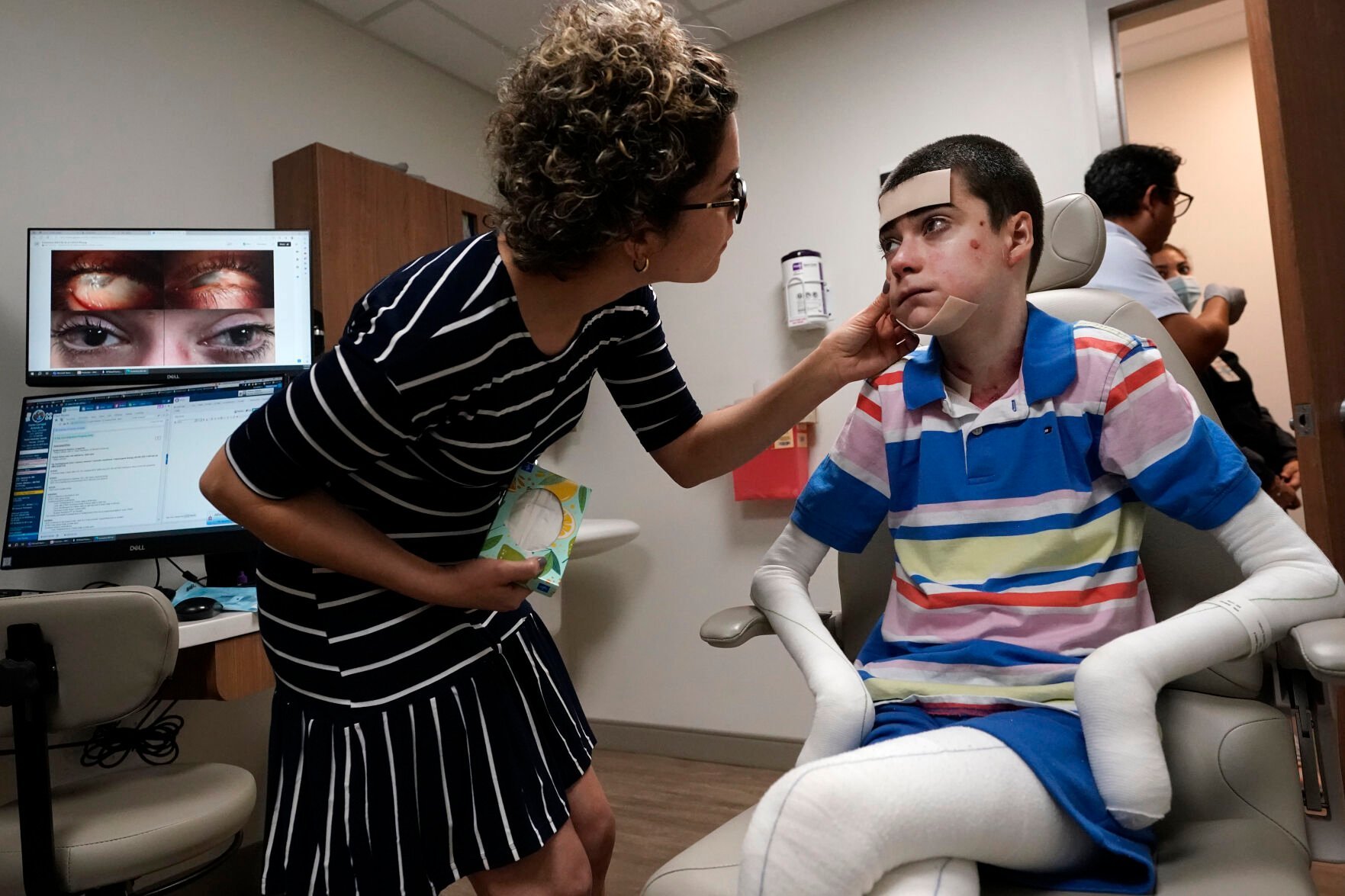
Wilfredo Lee, Associated Press
Photos of Antonio Vento Carvajal's eyes, left, photographed before and after surgery and gene therapy, are displayed on a computer screen as his mother, Yunielkys Carvajal, center, looks into his eyes while they attend a doctor's appointment, Thursday, July 6, 2023, at University of Miami Health System's Bascom Palmer Eye Institute in Miami.
“‘Yeah, I know you’re going to do it,'” Sabater recalled Antonio saying. “That gave me the energy to continue.”
At one point, Carvajal told Sabater about the experimental gene therapy gel for Antonio’s skin lesions. He contacted drugmaker Krystal Biotech to see if it could be reformulated for the boy’s eyes.
Suma Krishnan, co-founder and president of research and development for the Pittsburgh-based company, said the idea made sense and “it didn’t hurt to try it.”
Antonio’s condition is caused by mutations in a gene that helps produce a protein called collagen 7, which holds together both skin and corneas. The treatment, called Vyjuvek, uses an inactivated herpes simplex virus to deliver working copies of that gene. The eyedrops use the same liquid as the skin version, just without the added gel.
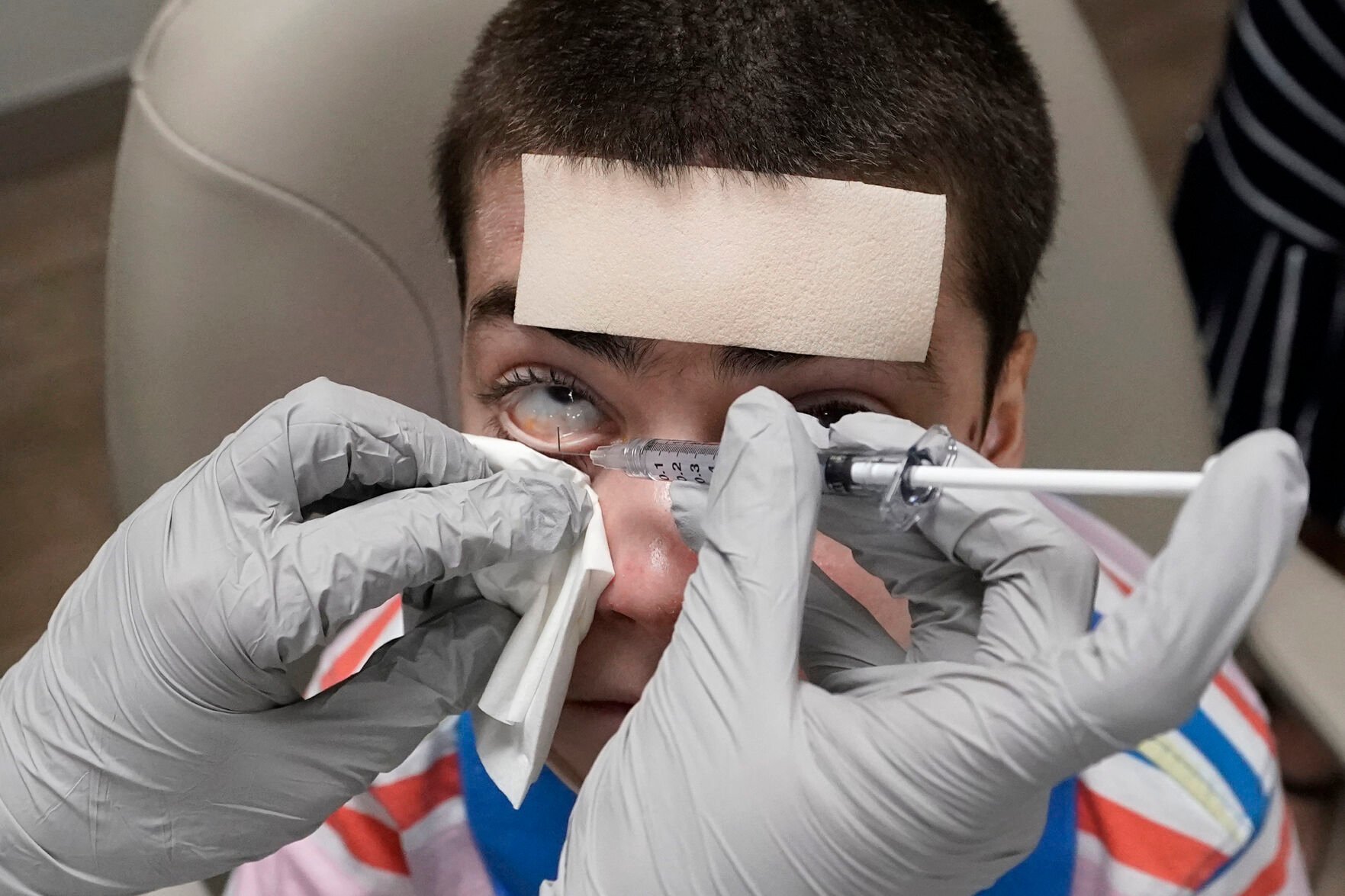
Wilfredo Lee, Associated Press
Dr. Alfonso Sabater, uses a syringe to apply gene therapy eyedrops to Antonio Vento Carvajal's eyes, Thursday, July 6, 2023, at University of Miami Health System's Bascom Palmer Eye Institute in Miami.
After two years, which included testing the drug in mice, the team got “compassionate use” approval from the U.S. Food and Drug Administration and permission from university and hospital review boards. Last August, Antonio had surgery on his right eye, after which Sabater started treating him with the eyedrops.
Krishnan said they were cautious, frequently watching to see that it was safe.
Antonio’s eye recovered from the surgery, the scarring didn’t return and there was significant improvement each month, Sabater said. Doctors recently measured the vision in Antoni’s right eye at a near-perfect 20/25.
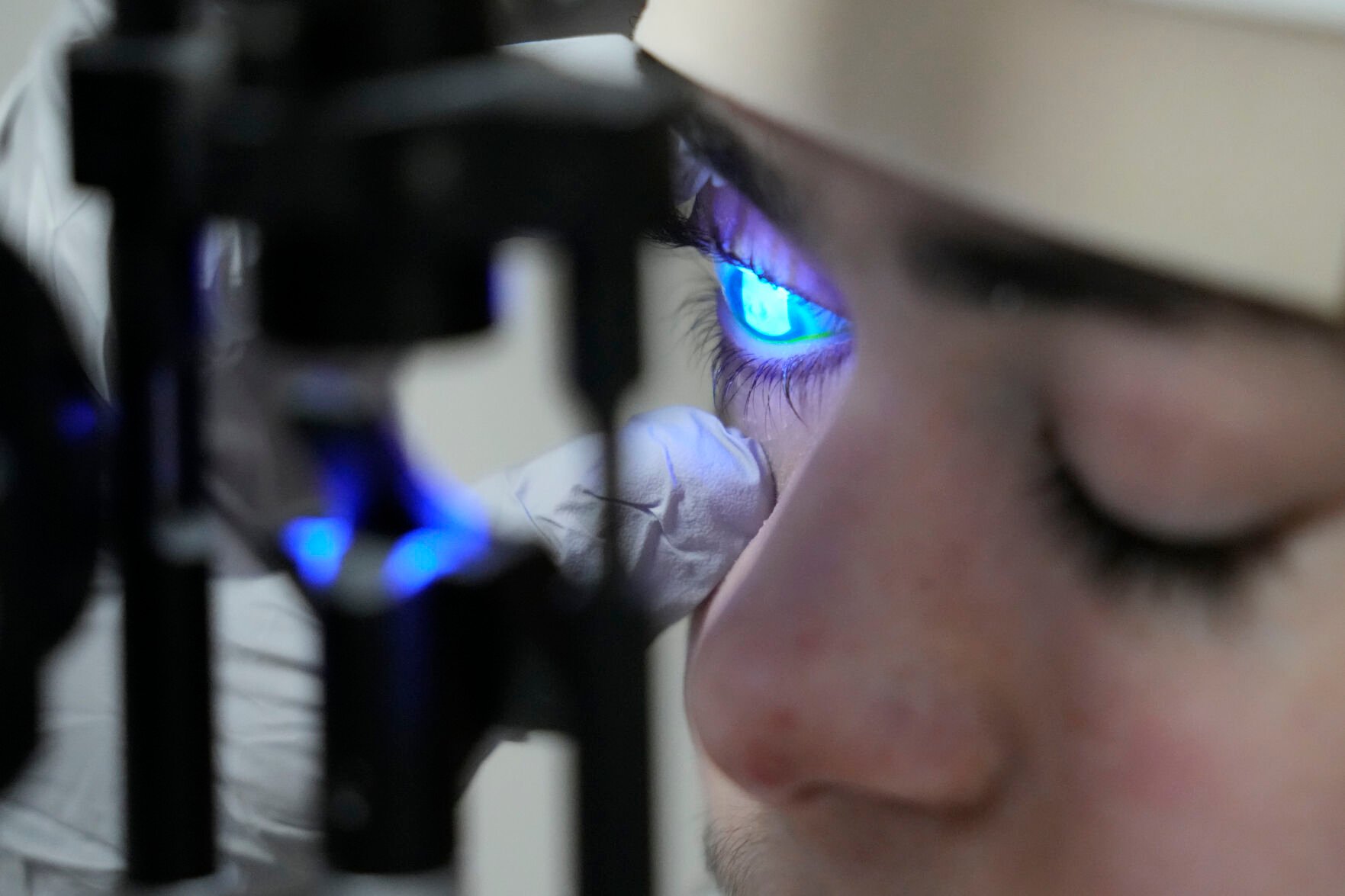
Wilfredo Lee, Associated Press
Dr. Alfonso Sabater, checks Antonio Vento Carvajal's eye under a blue light after applying a stain to check to see if more ulcers had developed, before a gene therapy treatment, Thursday, July 6, 2023, at University of Miami Health System's Bascom Palmer Eye Institute in Miami.
This year, Sabater began treating Antonio’s left eye, which had even more scar tissue. That one is also steadily improving, measuring close to 20/50, which Sabater said “is pretty good vision.”
Antonio comes to the eye institute for checkups almost weekly and gets the drops once a month. During visits, Antonio must wear protective clothing covering his arms, hands, legs and feet. Like other kids with the condition — who are sometimes called “butterfly children” — his skin is so fragile that even a touch can wound him.
Antonio still uses the skin gel, which was approved by the FDA in May and can also be used off-label on eyes. It doesn’t modify DNA, so it’s not a one-time treatment like many gene therapies.
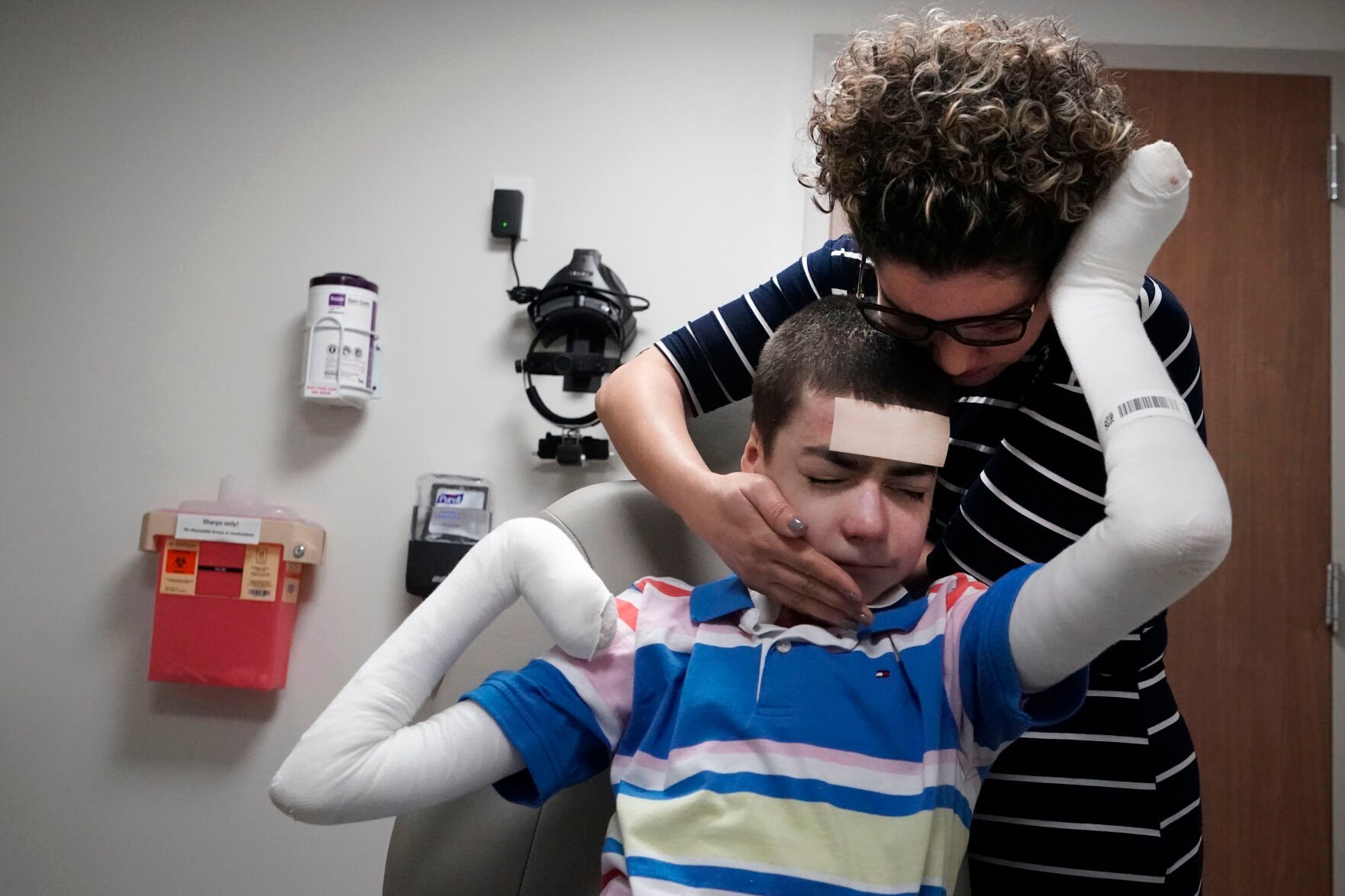
Wilfredo Lee, Associated Press
Yunielkys Carvajal, gives her son, Antonio Vento Carvaja, a hug and a kiss after a doctor's visit, Thursday, July 6, 2023, at University of Miami Health System's Bascom Palmer Eye Institute in Miami.
Sabater, director of the Corneal Innovation Lab at the eye institute, said gene therapy eyedrops could potentially be used for other diseases by changing the gene delivered by the virus. For example, a different gene could be used to treat Fuchs’ dystrophy, which affects 18 million people in the U.S. and accounts for about half the nation’s corneal transplants.
The prospect of treating more conditions this way is “exciting,” said Dr. Aimee Payne, a dermatology professor at the University of Pennsylvania who isn’t involved in the research. The approach “delivers gene therapy that really addresses the root cause of disease.”
With his vision restored, Antonio has enjoyed a typical teen pastime he’s wanted to do for quite a while: playing video games with his friends. And he finally feels safe walking around.
Sabater said the two-year journey seeking government and hospital approvals “was worth it. Just for Antonio, it was worth it … but also because it opens the space to treat other patients in the future.”
-
Gene therapy eyedrops restored a boy’s sight. Similar treatments could help millions
Ground Picture // Shutterstock
The COVID-19 pandemic revealed, among many things, the essential role medical workers play in our daily health and safety. One of the ways this manifested was in the recognition of a growing shortage of medical professionals.
In part, shortages have been—and will likely continue to be—driven by demographic change relative to demand. The U.S. population is expected to grow 10.6% by 2034, while the 65-and-over demographic will increase by more than 42%. This projected rise in the number of elderly residents will not only necessitate more sustained and specialized care for chronic conditions such as diabetes, dementia, and heart disease but more access to generalized care as well, given that those over age 65 seek physician care three to four times as much as younger people.
At the same time, a significant number of medical workers are leaving the profession either through retirement or as a result of the physical and mental toll the profession takes on them. Many workers who came out of retirement to work the front lines during the pandemic are once more retiring as the immediate threat recedes. The physical, mental, and emotional exhaustion can and has pushed qualified professionals to leave the field entirely.
One study published by the Mayo Clinic in September 2022 found that 63% of physicians reported signs of burnout, and the American Medical Association has characterized physician burnout as being at epidemic levels. Many medical professionals require up to a decade of education and training, and when burnout pushes fully trained professionals out of the field, it takes a long time to replace them.
Although shortages vary by region, some common threads tie this problem together. Difficulty in accessing care forces many Americans to seek emergency care as a last resort, putting a strain on emergency room workers and increasing patient costs. Shortages also may result in lower quality care, less face-to-face interaction with patients, longer wait times, and higher costs.
Using data from the Health Resources & Services Administration Workforce Projections, QMedic examined which roles in medicine are projected to have the greatest shortages by 2035.

Ground Picture // Shutterstock
The COVID-19 pandemic revealed, among many things, the essential role medical workers play in our daily health and safety. One of the ways this manifested was in the recognition of a growing shortage of medical professionals.
In part, shortages have been—and will likely continue to be—driven by demographic change relative to demand. The U.S. population is expected to grow 10.6% by 2034, while the 65-and-over demographic will increase by more than 42%. This projected rise in the number of elderly residents will not only necessitate more sustained and specialized care for chronic conditions such as diabetes, dementia, and heart disease but more access to generalized care as well, given that those over age 65 seek physician care three to four times as much as younger people.
At the same time, a significant number of medical workers are leaving the profession either through retirement or as a result of the physical and mental toll the profession takes on them. Many workers who came out of retirement to work the front lines during the pandemic are once more retiring as the immediate threat recedes. The physical, mental, and emotional exhaustion can and has pushed qualified professionals to leave the field entirely.
One study published by the Mayo Clinic in September 2022 found that 63% of physicians reported signs of burnout, and the American Medical Association has characterized physician burnout as being at epidemic levels. Many medical professionals require up to a decade of education and training, and when burnout pushes fully trained professionals out of the field, it takes a long time to replace them.
Although shortages vary by region, some common threads tie this problem together. Difficulty in accessing care forces many Americans to seek emergency care as a last resort, putting a strain on emergency room workers and increasing patient costs. Shortages also may result in lower quality care, less face-to-face interaction with patients, longer wait times, and higher costs.
Using data from the Health Resources & Services Administration Workforce Projections, QMedic examined which roles in medicine are projected to have the greatest shortages by 2035.

-
Gene therapy eyedrops restored a boy’s sight. Similar treatments could help millions
Emilia Ruzicka // QMedic
Medical specialties have unique supply and demand factors and face different obstacles in meeting demand. Overall, the specialties that can score Medicare-funded residency slots tend to produce more physicians and stand a better chance at meeting demand.
Nursing, which is projected to have among the highest shortages by 2025, is often plagued by many of the hardships and stressors that befall physicians but does not have as much funding support as other areas of medicine. Many nursing schools don't have enough faculty or access to clinical sites to accept the number of applicants they receive annually. Pay incentives are further driving this issue; most nurses qualified to teach can earn much more working in a hospital setting. Nurses have also reported growing rates of physical and verbal intimidation from patients.
The American Hospital Association recommends the federal government invest more money in nursing schools and salaries and put forth federal protections against violence in order to bolster the workforce and slow the stream of nurses leaving the profession.
Emilia Ruzicka // QMedic
Medical specialties have unique supply and demand factors and face different obstacles in meeting demand. Overall, the specialties that can score Medicare-funded residency slots tend to produce more physicians and stand a better chance at meeting demand.
Nursing, which is projected to have among the highest shortages by 2025, is often plagued by many of the hardships and stressors that befall physicians but does not have as much funding support as other areas of medicine. Many nursing schools don't have enough faculty or access to clinical sites to accept the number of applicants they receive annually. Pay incentives are further driving this issue; most nurses qualified to teach can earn much more working in a hospital setting. Nurses have also reported growing rates of physical and verbal intimidation from patients.
The American Hospital Association recommends the federal government invest more money in nursing schools and salaries and put forth federal protections against violence in order to bolster the workforce and slow the stream of nurses leaving the profession.
-
-
Gene therapy eyedrops restored a boy’s sight. Similar treatments could help millions
Emilia Ruzicka // QMedic
Lack of proper health care and good hospitals exacerbates access issues that the roughly 46 million Americans who live in rural areas already face. Even before the pandemic, almost a quarter of rural Americans reported access to quality hospitals and doctors to be a challenge.
Additionally, people in rural communities tend to be older, less affluent, and underinsured relative to those in larger metro areas, and thus their heightened need for medical care collides with equally heightened financial challenges. Compounding the issue is the fact that rural medical facilities cannot generally afford to pay medical staff the salary they could expect in denser urban settings, which in turn has contributed to a dearth of available practitioners.
Most doctors practice at the location of their residency or within their resident facility's network, and most government-funded residencies are in urban medical centers. One result of this is so-called "doctor deserts" in many rural communities. The Association of American Medical Colleges reported in 2021, at the height of the pandemic, that three of every five federally designated health professional shortage areas were rural. As of July 2023, the Health Resources & Services Administration found that health professional shortage areas continue to be significantly more common in rural areas than urban ones.
Emilia Ruzicka // QMedic
Lack of proper health care and good hospitals exacerbates access issues that the roughly 46 million Americans who live in rural areas already face. Even before the pandemic, almost a quarter of rural Americans reported access to quality hospitals and doctors to be a challenge.
Additionally, people in rural communities tend to be older, less affluent, and underinsured relative to those in larger metro areas, and thus their heightened need for medical care collides with equally heightened financial challenges. Compounding the issue is the fact that rural medical facilities cannot generally afford to pay medical staff the salary they could expect in denser urban settings, which in turn has contributed to a dearth of available practitioners.
Most doctors practice at the location of their residency or within their resident facility's network, and most government-funded residencies are in urban medical centers. One result of this is so-called "doctor deserts" in many rural communities. The Association of American Medical Colleges reported in 2021, at the height of the pandemic, that three of every five federally designated health professional shortage areas were rural. As of July 2023, the Health Resources & Services Administration found that health professional shortage areas continue to be significantly more common in rural areas than urban ones.
-
Gene therapy eyedrops restored a boy’s sight. Similar treatments could help millions
Emilia Ruzicka // QMedic
Factors such as state population, geography, state-level policy, technology, and models of care all present varying landscapes for patients seeking care. Regionally, the South and West are projected to have the highest physician shortages. On a state level, California, Florida, and Texas are expected to experience the largest physician shortages, due in part to their anticipated population growth.
State-level solutions to address and reverse the shortages in medical roles across the U.S. largely focus on looser licensure and financial incentives. Cross-state licensing, which bloomed during the pandemic as a means of assisting physicians with telehealth work under the auspices of the Interstate Medical Licensure Compact, could mitigate shortages in some regions of the country. As of July 2023, 39 states and the District of Columbia are participating in the compact.
Some states have strategized to help relieve student loan debt in response to the shortages. Illinois, for example, repays up to $50,000 in student loans for nurses and physicians who agree to work in designated shortage areas in the state for up to four years.
Federal investment in the state shortages also plays a key role in addressing the shortages. In December 2020, Congress expanded support for Medicare-supported graduate medical education, appropriating funds to create 1,000 such positions over a five-year period in hospitals training residents over their cap or in states with new medical schools, teaching hospitals in rural areas, and hospitals that care for underserved communities. The following year, the Resident Physician Shortage Reduction Act was introduced, which would add 14,000 residency positions over seven years. The act was reintroduced in 2023 with bipartisan support and is pending Congressional approval.
Data reporting by Emilia Ruzicka. Story editing by Brian Budzynski. Copy editing by Tim Bruns. Photo selection by Clarese Moller.
This story originally appeared on QMedic and was produced and distributed in partnership with Stacker Studio.
Emilia Ruzicka // QMedic
Factors such as state population, geography, state-level policy, technology, and models of care all present varying landscapes for patients seeking care. Regionally, the South and West are projected to have the highest physician shortages. On a state level, California, Florida, and Texas are expected to experience the largest physician shortages, due in part to their anticipated population growth.
State-level solutions to address and reverse the shortages in medical roles across the U.S. largely focus on looser licensure and financial incentives. Cross-state licensing, which bloomed during the pandemic as a means of assisting physicians with telehealth work under the auspices of the Interstate Medical Licensure Compact, could mitigate shortages in some regions of the country. As of July 2023, 39 states and the District of Columbia are participating in the compact.
Some states have strategized to help relieve student loan debt in response to the shortages. Illinois, for example, repays up to $50,000 in student loans for nurses and physicians who agree to work in designated shortage areas in the state for up to four years.
Federal investment in the state shortages also plays a key role in addressing the shortages. In December 2020, Congress expanded support for Medicare-supported graduate medical education, appropriating funds to create 1,000 such positions over a five-year period in hospitals training residents over their cap or in states with new medical schools, teaching hospitals in rural areas, and hospitals that care for underserved communities. The following year, the Resident Physician Shortage Reduction Act was introduced, which would add 14,000 residency positions over seven years. The act was reintroduced in 2023 with bipartisan support and is pending Congressional approval.
Data reporting by Emilia Ruzicka. Story editing by Brian Budzynski. Copy editing by Tim Bruns. Photo selection by Clarese Moller.
This story originally appeared on QMedic and was produced and distributed in partnership with Stacker Studio.






